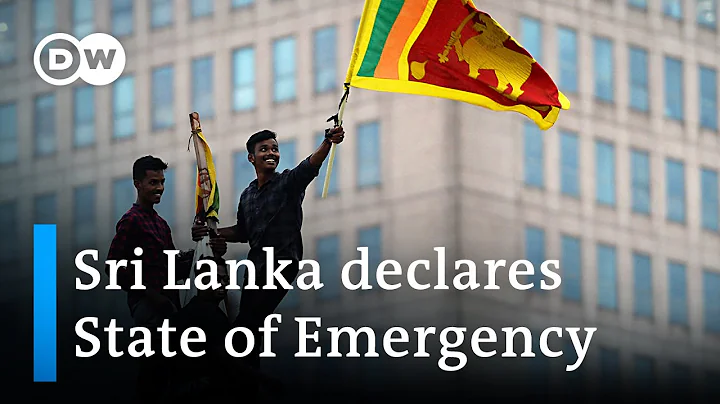Recently, Sri Lanka has encountered a serious economic crisis . The country has declared bankruptcy, and protests broke out in Colombo, the capital of Sri Lanka. Faced with this situation, the Prime Minister and President of Sri Lanka announced their resignations one after another. According to AFP 13 report, Sri Lanka declared a national state of emergency.
This article will focus on analyzing the reasons why Sri Lanka is in crisis. In fact, at its core, this is the result of the joint action of five factors.

First of all: it is not "truly independent" of in nature.
Sri Lanka is a country with a long history, having experienced 25 years of civil war. After the civil war, the Sri Lankan government implemented liberalization policies to attract foreign investment. The International Monetary Fund provided a loan of US$2.6 billion. Therefore, starting in 2011, Sri Lanka's economic growth rate has been above 7% for many consecutive years.
Although the economy continues to grow, it is not fully "independent" and is still dependent on the West. For example, after the end of the Sri Lankan civil war, China recommended an important project, namely port trade services, to help Sri Lanka's economic development. Taking advantage of Sri Lanka's location near the Indian Ocean waterway, it will add another huge and sustainable source of foreign exchange income for Sri Lanka.
Logically speaking, as long as this strategic level project can be continued, it will bring great help to the country's economy. However, the United States and the West have come up with so-called "green environmental protection" plans, which are essentially trying to support Sri Lanka. He himself lacked the awareness of "real independence", so he began to waver about China's investment , and eventually turned to the United States and the West, launching a so-called "green agriculture strategy" that banned the use of pesticides and chemical fertilizers in agriculture across the country.
This move is equivalent to destroying one's martial arts skills. After the implementation of this agricultural strategy, Sri Lanka's food production instantly dropped to about one-third of its previous level. The food shortage problem we are facing now is, to a certain extent, inextricably linked to this strategy.
Second: A single economic structure leads to a weak ability to resist risks.
Sri Lanka suffered from British colonial rule, and the legacy of the colonial economy has caused the country's economy to still rely heavily on a few crops such as tea and rubber. This is actually another manifestation of its lack of "independent historical essence."
At the same time, from the perspective of industrial structure, Sri Lanka's industrial base is very weak, mainly agriculture, tourism and clothing and textile light industry. At least 72% of the country's population is directly or indirectly engaged in agriculture. This single industrial structure makes it resistant to risks. ability is weak.
Third: Deterioration of the external environment
The "black swan" of the epidemic has severely hit Sri Lanka's tourism industry.
The tourism industry is one of Sri Lanka's main sources of foreign exchange. After the outbreak of the new crown epidemic, the number of tourists coming to Sri Lanka plummeted, resulting in more than 200,000 tourism industry employees losing their jobs, which also cost the country nearly 5 billion US dollars a year. Foreign exchange earnings. According to data from the Central Bank of Sri Lanka, the country’s economic growth rate in 2020 was -3.6%.
In the second half of 2021, European and American countries relaxed travel bans, allowing Sri Lanka's tourism industry to begin to recover. The Sri Lankan government even designated 2022 as the "Sri Lanka Tourism Year" and set a goal of generating US$10 billion in revenue from the tourism industry by 2025. , to rebuild the country’s foreign exchange reserves and sovereign debt, but the overall situation has not improved significantly. At the same time, due to the impact of the epidemic, another important pillar of Sri Lanka's foreign exchange, remittances from overseas migrant workers, has also decreased significantly. The combination of the two has resulted in a significant decrease in Sri Lanka's foreign exchange income.
In addition, the geopolitical conflict between Russia and Ukraine became the last straw that crushed Sri Lanka's economy.
The escalation of the Ukraine crisis and other factors have led to rising global food and energy prices, making it more difficult for Sri Lanka, which is already tight on foreign exchange, to import enough food and energy, making its domestic inflation problem more serious. At the same time, rising inflation and material shortages have further affected the normal operation of society.
In terms of agriculture, even though it is located in a tropical area with good conditions for growing grain, the geopolitical conflict between Russia and Ukraine has caused the price of fertilizer raw materials to skyrocket. Regarding the issue of grain and fertilizer, I wrote in the article "Double the chips, Russia will "kill" all sides, and Europe will be destroyed. Carefully analyzed in "Sacrificed". Sri Lanka is short of foreign exchange reserves and heavily in debt. Even if it wants to buy fertilizer now, it is unable to do anything. As a result, food production has also been reduced. Not only that, they also have no ability to import daily necessities such as food and medicine.
Demand exceeds supply and prices rise. Even if milk powder, bread, rice, vegetables, sugar, rice and other foods are rationed, it is still difficult to ensure supply, and these situations will trigger humanitarian crises .
Fourth: "Man-made disasters" have made Sri Lanka even worse.
In 2019, after Gotabaya became the president of Sri Lanka, he changed the monetary and fiscal policies after the civil war and tried to stimulate exports to obtain U.S. dollars by printing money. This is the same as Turkey Erdogan’s approach , I also said it in the article "Abandoning pawns can't keep handsome: Turkey, which has three kills in stocks, foreign exchange and debt, is just the first step of a "pilot"". The economic crisis faced by Sri Lanka today is actually similar to that of Türkiye.
Judging from past situations, this approach not only dilutes domestic debt, but also stimulates exports, thereby earning more foreign exchange to repay foreign debt. Basically, it works. However, after the epidemic, it continued to "release water". Although it stimulated export trade, it also led to currency depreciation. In March this year alone, Sri Lankan rupee fell 31% against the US dollar, reaching 302 Sri Lankan rupees per US dollar. At the same time, the conflict between Russia and Ukraine has led to an increase in energy prices. On the one hand, the local currency has depreciated, and on the other hand, import prices have increased, which has greatly increased the government's cost of repaying foreign debt.
Against the background of the epidemic and war, the long-term finance that cannot make ends meet has no more foreign exchange to import living and production materials. Faced with the shortage of materials, the Sri Lankan government can only implement an import ban, and the import of food, medicine, automobiles and other commodities is prohibited. As a result, the price of goods is pushed higher, making it unaffordable for most ordinary people.
Fifth: A helpless situation
Of course, the Sri Lankan government has no choice but to implement this policy because its foreign trade and finance have been running double deficits for many years. Even after the golden decade of tourism, it is still running a long-term deficit. Except for the trade balance which was positive at US$8.2 billion in 2014, the other years from 2008 to 2017 were all deficits, with the cumulative deficit approaching US$50 billion.
In order to support the twin deficits, they have always been "paying debt with debt."
According to data from the Central Bank of Sri Lanka, from 2009 to 2017, the total external debt increased from US$20.913 billion to US$51.824 billion. In less than 10 years, the scale of internal and external debt more than doubled, with an average annual growth rate of 12%.
But in terms of foreign exchange reserves, from 2009 to 2017, official foreign exchange reserves were below US$8 billion. In the past two years, Sri Lanka's foreign exchange reserves have continued to decline. More importantly, a huge debt is due this year, so they have chosen to implement interest rate cuts, money printing and an export ban. The purpose is to save foreign exchange and use the saved foreign exchange to import energy and Repay foreign debt. But it backfired and worsened Sri Lanka's economic crisis.
It is under the influence of these five reasons that Sri Lanka is like a "drunkard", staggering into the abyss caused by the economic crisis.





















